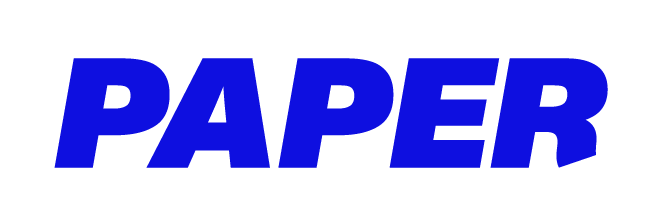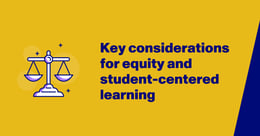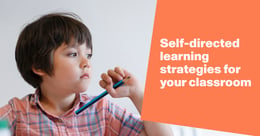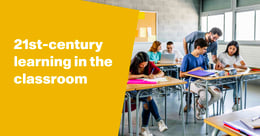
Universal design for learning principles: Providing multiple means
Every teacher has a unique approach to their craft, but all dedicated educators share one common goal: to nurture the growth and development of every student in their classrooms.
The principles of universal design for learning foreground inclusive education best practices to make sure all students are fully supported in their learning environments.
[READ: “Tools for customizing education: Voice, text, and more”]
In the pursuit of accessibility and inclusion for all learners, we’ll explore what universal design for learning is and discuss several key pillars of this approach to education.
Origins, applications, and the key principles behind universal design for learning
Today, universal design for learning—sometimes called UDL—is a widely recognized and scientifically informed approach to education. Where does it come from, what is it designed to achieve, and what are its core principles? Read on to learn more.
Universal design: From architecture to education
To understand where universal design for learning principles come from, we actually have to look to the world of architectural design.
According to the Ronald L. Mace Universal Design Institute, the history of universal design emerged from the earlier concept of barrier-free design. Put simply, universal design is rooted in the premise that, from the outset, environments should be made to be seamlessly accessible for all people.
This is in contrast to retrofitting approaches that may require expensive, unsightly, or inconvenient segregated upgrades to improve accessibility. One of the benefits of universal design is that it can produce better results for the entire population, including people who may otherwise feel adequately served by less accessible approaches to design.
In time, the principles of universal design were applied to other areas of life, from consumer products to education.
The emergence of universal design for learning
A Harvard Graduate School of Education article about the evolution of universal design for learning explains how this distinct approach began to take shape in the 1990s. It was then that Dr. David Rose, Dr. Anne Meyer, and their colleagues at an organization now called CAST—formerly the Center for Applied Special Technology—began to formalize the tenets of this innovative concept.
Originally, the group was focused on using early personal computers to serve as assistive technology for students with physical and learning disabilities. Over time, however, the group began to see that improving course design and making it flexible enough to suit all learners could be more effective, and more beneficial, than providing customized support to individual students on an as-needed basis.
Universal design for learning emphasizes that it’s not the students who need to change—it’s the curriculum.
[READ: “What teachers gain from student-centered learning”]
Why are districts, schools, and teachers interested in pursuing universal design for learning?
The profile of universal design for learning has expanded greatly since its early days. In fact, as CAST notes, UDL’s place in public policy—which began at the federal level with 2008’s Higher Education Opportunity Act—has implications for learners in kindergarten through postsecondary education and beyond.
Additionally, many educators acknowledge that teaching students necessarily involves finding ways to accommodate learner variability, which is naturally present in all classrooms. UDL implementation offers an opportunity to remove barriers and ensure access.
In an Edutopia article about embracing the mindset behind universal design for learning, author Sarah Schwartz observes that teachers are usually driven by a common purpose to prepare students for lifelong success—not just to pass tomorrow’s test.
Universal design for learning principles help educators ensure they’re creating a space where all learners can make progress toward rewarding careers, pursuits in higher education, and lifelong growth.
[READ: “The K-12 guide to college and career readiness”]
The 3 core universal design for learning principles
CAST states that UDL practices center on creating multiple pathways related to engagement, representation, and action and expression, which we outline below.
1. Engagement throughout the learning journey
When you approach lesson planning, how do you decide what you’ll do to help students get interested in the material, stay focused, and remain motivated? Will you assign solo work or small-group activities? What about encouraging active learning or delivering a more traditional lecture?
As with all of the universal design for learning principles, student engagement demands choice and empowerment. No single prescribed learning experience will fit the bill for everybody, and students need to know that there are many different ways they can participate.
Carleton College’s series of blog posts on engaging students using the universal design for learning framework has great advice for how to recruit interest, promote persistence, and support self-regulation.
Here are just a few quick tips from these resources to try out:
- Prioritize student agency using culturally relevant materials in a distraction-free environment.
- Help students set checkpoints for their goals so they can stay on track and incorporate meaningful feedback.
- Support students’ personal growth through goal-setting, stress management, opportunities for reflection, and more.
[READ: “4 effective self-directed learning strategies”]
2. Representation of new concepts
In her capacity as a consultant, Dr. Katie Novak founded Novak Education, an organization that provides professional development and other services surrounding universal design for learning and a variety of other topics.
In her blog post on the universal design for learning principle of providing various means of representation, Novak likens relevant teaching strategies to the use of a flexible tool like a rich text editor. Just as Google Docs will allow the user to incorporate text alongside multimedia representations of content, teachers can serve up the same course material in a wide variety of different formats. For example, in a social sciences class, reading a book or watching a video might be equally acceptable ways to achieve a specific learning goal.
Following Novak’s example in the post, let’s explore how multiple methods of representation might play out:
- Instead of requiring all students to read a chapter in their textbook, they could be given the option to use text-to-speech support or an interactive activity.
- Multimedia representations could help support student learning by providing additional pathways to take in information and absorb concepts.
- Scaffolded support can help students contextualize the current lesson alongside concepts they already know—or it could provide a preview of what they need to learn.
3. Different ways for students to take action and express themselves
As CAST points out in its UDL guidelines on providing multiple means of action and expression, learning requires a mixture of different physical, communicative, and organizational activities. And not every student will have the ability—or the desire—to participate in these activities the same way. In the pursuit of shared learning outcomes, it’s important that educational environments provide a variety of options so students can take part in the way that suits their needs and interests.
This kind of inclusive teaching can also ensure students have access to assistive technology and a wide assortment of tools for interacting with content, sharing their findings, and organizing their thoughts and goals.
As we’ve discussed before, teachers and administrators can think strategically about how to use technology to support student-centered learning. To be successful, districts need to provide adequate training and align on how to integrate new tools into the classroom environment. This guidance holds true for the process of leveraging technology in universal design for learning initiatives too.
The unfurling path toward implementing universal design for learning principles
As the vision of a school system informed by universal design for learning principles comes into sharper focus, it’s worth considering that the ideal outcome is less of a destination and more of a structural commitment to ongoing improvement.
After all, teaching excellence is a state of continuous striving—the ambition to make every school year more inclusive, more inspiring, and more universally applicable than the last.
Looking for more inspiration about how to help students thrive on their own terms? Check out our free ebook, “5 ways student-centered interventions can increase engagement.”



![3 ways game elements can drive educational engagement [Infographic]](https://paper.co/hs-fs/hubfs/Paper-Blog_3-ways-game-elements-can-drive-educational-engagement.jpg?width=260&height=136&name=Paper-Blog_3-ways-game-elements-can-drive-educational-engagement.jpg)


